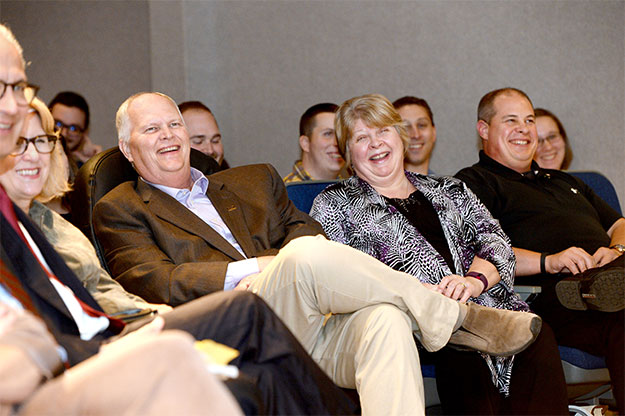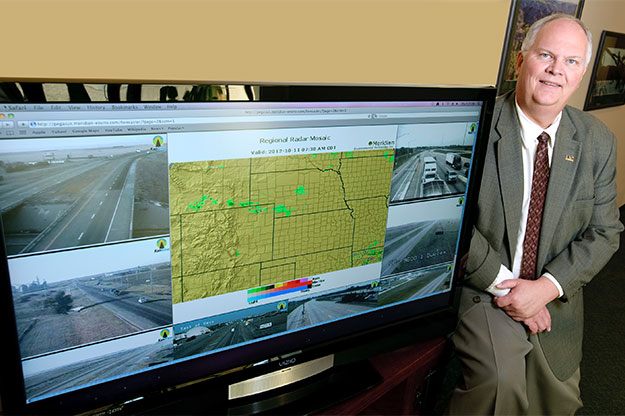Feet on the ground, head in the clouds
Friends and colleagues take time to celebrate career and accomplishments of Leon Osborne, the so-called ‘People’s Weatherman’ from UND

There’s a much ballyhooed account in local lore surrounding UND Chester Fritz Distinguished Professor Leon Osborne, Jr. and the 1997 Red River Valley flood.
The short version, documented in Ashley Shelby’s 2008 book Red River Rising: The Anatomy of a Flood and the Survival of an American City, is that Osborne called it before it happened. While some official sources were reluctant to go so far as to publically forecast the flood’s oncoming onslaught ( for fear of inciting widespread panic) Osborne, a longtime director of UND’s Regional Weather Information Center (RWIC), and his staff were actively advising people who called their office to “buy flood insurance and get it yesterday.”
At the time, any information outside of the National Weather Service regarding weather and a potential flood was considered “unofficial.”
“Obviously [others] felt I was doing things I should have stayed out of,” said Osborne, in an excerpt from Shelby’s book. “But that’s like a physician that sees that another physician doesn’t have the right diagnosis. We don’t have a Hippocratic Oath in meteorology – but maybe we should.”
The legend of Osborne’s forecasting skills and meteorology prowess, already well established in the region, only grew as word of mouth spread after the 1997 flood – the worst ever in the habitable history of Grand Forks and East Grand Forks.
Osborne, through a jovial demeanor and a trust forged with the region’s agricultural community, has become known over the years as the “People’s Weatherman.”
Monday night, Osborne’s career and accomplishments were celebrated by friends and colleagues across campus and beyond. More than 100 people showed up to honor Osborne, who recently was diagnosed with pancreatic cancer, and the impact he’s had on them and the entire nation.
“It’s so gratifying and feels great to see so many people pay tribute to Leon, a man who has done so much for so many people over the years,” said Mark Askelson, a UND professor of atmospheric sciences and former student of Osborne’s. “It’s special because, even though Leon has a passion for science, his true passion was people.”

Spin-off invention
Osborne is one of the founding members of the Department of Atmospheric Sciences at UND, and was a prime mover in establishing the RWIC, which he now heads.
During his more than 30 years at UND, Osborne has been involved in research that applies weather information technology to solving everyday problems. Many of his contracts focus on surface transportation weather research — work that has placed UND as the most nationally recognized university in this research area.
“Leon represents to me what I’ve been talking about when I say that this is a place to reach new frontiers,” said UND President Mark Kennedy. “Leon always will be one of the star professors on this campus.”
A native of northwest Texas, Osborne received his master’s degree in meteorology from the University of Oklahoma in 1979 and his bachelor’s degree in physics from Utah State University in 1976. He has been with UND since 1979.
Osborne was involved in one of the first and best examples of UND scholarly scientific research spinning off to the private sector to benefit the public.
In late 1996, Osborne and his UND team developed the Advanced Transportation Weather Information System (ATWIS), which was operated out of the RWIC in Odegard Hall. It marked the beginning of “24/7” weather information and coincided with marked improvements to computer operating systems that made the technology applicable in the public realm.
It also became the impetus for the National Advanced Traveler Information System, known today as “511.” The 511 system provides a simple access number for motorists and travelers to get on-demand weather and road information. The technology was conceived by Osborne and colleagues at UND’s John D. Odegard School of Aerospace Sciences.
To bring the 511 to the public, Osborne, his wife, Kathy, and colleagues Mark Owens and Bryan Hahn launched a new startup business called Meridian Environmental Technology, Inc. After some tweaking to the old ATWIS system to make it more efficient and market ready, Meridian started securing contracts, including a major deal with the State of Minnesota. Today, the 511 system is active in nearly all states.
Meridian eventually was acquired by Iteris, Inc., based in Santa Ana, Calif. The company took over Meridian’s advanced traveler information systems and all of the weather activities that made the 511 system tick.

Farmer’s friend
Outside of his entrepreneurial work, Osborne also is known as a pretty darn good weather guy, especially by farmers in the region, who’ve become accustomed to his uncanny precision with winter forecasts and his spring moisture predictions. He and the RWIC have become agriculture’s “go-to climate and weather information service” for the region.
Osborne was known for traveling the region to give presentations on future weather trends to packed houses of farmers and agricultural officials.
“When Leon had the floor, everyone stopped what they were doing and listened to what he had to say,” said UND Aerospace Dean Paul Lindseth. “These farmers made decisions based on Leon’s forecasts as to what crops they would grow.”
This reputation dates back to the 1980s when Osborne and UND started getting serious about ag weather with their “AgWINDS project.” AgWINDS provided software to farmers and ranchers to help them make decisions on agricultural practices using computer-based weather well before the Internet was widely available. Osborne’s team would leverage their work on AgWINDS with research on ATWIS to build what would become the 511 system years later.
Osborne also was a well-respected TV meteorologist on regional public television. His reports were must-see TV for area growers from the late 1980s into the 1990s.
“As a young famer, I relied on that information so heavily,” said Ron Selzer, a farmer in rural Knox, N.D. “He had a way of presenting information so farmers could understand what was going on out there. We really appreciated that.”
Osborne was visibly touched by the outpouring by well-wishers who attended Monday’s event. There were laughs, lots of hugs and some tears. He vowed to keep fighting — and teaching.
“We’re hoping to be around for years to come because, frankly, I have lots of students,” he said. “The things this disease has taught me is the value of being with people.”
Some might argue, however, that’s a lesson Osborne already had down pat.


